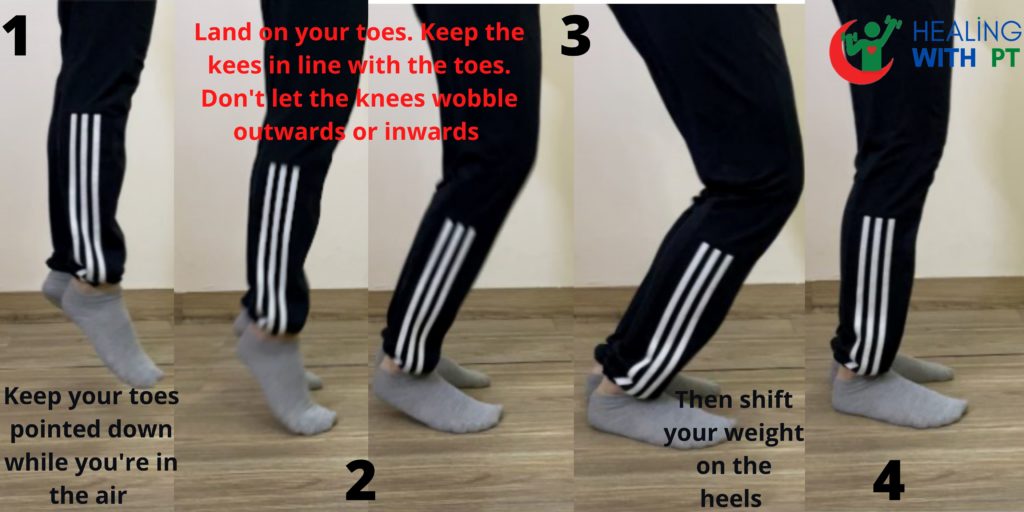Raise your hand if you’ve ever felt a sharp pain along the front of your lower legs after a long run. Most people who start jumping rope or suddenly increase their running distance or pace have this pain.
You might even experience it if you spend too much time jumping on the trampoline.
This pain is commonly known as shin splints. But the medical terminology for it is Medial Tibial Stress Syndrome.
The good news is that it’s not a major problem that can stop you from playing the sport you love or exercising the way you enjoy it. There are a few simple solutions that you can try out to get rid of shin splints. And in this article, we’ll share those with you.
We’ll also cover some precautions that you can take to not have to deal with this painful condition again.
So if you’re new to jump roping or running and somebody has warned you about shin splints, then this article has all the tips you need to save yourself from ever suffering this injury.
Ready? Let’s go!
But First, What Is Medial Tibial Stress Syndrome or Shin Splints?
The front of our legs has some small muscles. The primary one is called Tibialis Anterior (TA). Its job is to lift your foot upwards and rotate it inwards. This is the muscle that can get sore and injured when you start jumping too suddenly or aggressively without proper training.
Tibialis Anterior also maintains the arch of your foot. If your arch collapses too much when you land after a jump then this muscle is overworked. And that can lead to pain.
Medial Tibial Stress Syndrome is thus a condition that results from a more than usual stress on the shinbone and overactivity of TA muscle. About 4-19% of the athletic population suffers from shin splints.
Shin splints feel like sharp pain in the anterior and slightly lateral (outside) sides of the lower 1/3rd of your leg. There might also be tenderness on touching the legs and mild swelling in some cases.
The pain can come and go with the increase and decrease of activity respectively. Or it may be continuous pain and lead to stress fractures if you don’t take preventive actions at the right time.
Stress fractures, as the name indicates, are small tiny breaks in your bones that develop over time due to excessive repetitive forces. These usually happen in the weight-bearing bones of the legs and feet.
Some risk factors for shin splints include [i]
- Increasing intensity of exercise without proper training
- Running, dancing or jumping on hard surfaces
- Improper shoes that fail to absorb pressure when you land, causing your TA muscle to absorb all the weight of your body.
- Being overweight
- Excessive inward rotation of the foot while walking, running, jumping, dancing etc. This biomechanical movement is called hyper pronation of the foot.

5 Must-Know Tips for Shin Splints Rehab
And now, here are the tips you need to remember to recover from shin splints the right way:
1. Let It Rest
Rest may be the key for shin splints rehab. This condition results from an overactivity of the TA muscle and giving it the time to heal and readjust can pay off down the line.
Studies show that athletes might require 2-6 weeks, on average, of relative rest and a break from the sport.
Active rest might be preferable for most people. Here, you should try to maintain some level of activity in your feet and TA muscle, but this activity should be of less intensity than your regular exercise. [ii]
2. Apply Ice
Cryotherapy might help in case there is inflammation along the length of the shinbone. Ice can help decrease the pain by numbing the area. And it also contributes to increased blood flow and faster recovery. But not everyone needs ice for shin splints rehab.
You can repeat an ice massage several times a day in the acute stage. And only apply ice for about 7-10 minutes.
3. Stretch the Muscles Around Your Shinbone
Stretching can give you a feeling of ease while helping the muscles recover. It also ensures that the TA muscle doesn’t go into spasm due to pain. Studies show that regular stretches can change the viscosity of muscles and help with healing. [iii]
You need to stretch the calf muscles (gastrocnemius and soleus), Tibialis Anterior muscles and foot muscles.



4. Gently Restart Exercising
In this stage, you’ll want to start a graded loading exposure program.
It’s just a fancy term that means slowly increasing your exercise intensity. Or in other words, remember the phenomenon of timely progression rather than starting back on the same level that you were before the injury.
Begin exercising or jumping for only a few minutes with low intensity. And progress as you gain strength in your foot and calf muscles. [iv]
You must avoid running on hills, walking over uneven surfaces, and jumping or dancing on hard surfaces while you’re beginning to get back to the sport.
Here are two exercises you should try to build strength in your muscles during shin splints rehab:
- Toe raises to build up strength in the foot arch
- Heel raises to strengthen calf muscles to balance the load experienced in jumping.

5. Improve Your Posture
While you’re on a muscle strengthening program to get back to your favorite sport, you need to start improving your foot posture as well.
That’s all the more important if the cause of your shin splints is a bad landing position or a flat arch. Start by learning the proper landing techniques for jumping rope and running.
The rule you must remember here is to land on your toes and not the heels while slightly bending your knees to land softly.

You should also learn to modify foot control. That means if your foot is turning inwards too much, then you need to practice landing while maintaining your arch. Also, jump on softer surfaces such as a jump rope mat or add shock-absorbent insoles in your running shoes.[v]
Are You New to Jump Roping? Here Are the Ways You Can Prevent Getting Shin Splints
We’ve heard it a million times: Prevention is better than cure. That holds true in almost everything in life – including shin splints. Here are some shin splints prevention techniques you should remember:
1. Start Slow and Know Your Body’s Limits
Your body needs time to adjust to a new workout routine or a new movement pattern. So ease into running, jumping rope or dancing. Give your body the time it needs to build the required strength in your TA muscles.
Listen to your body’s warning signs. Don’t overdo your workouts just because you want to stick to your plan.
2. Don’t Forget to Stretch
Stretching is a part of the shin splints rehab program and it’s also great for preventing shin splints. Practice dynamic foot and calf stretches before starting your workout. And do some static stretches afterwards.
Study shows that stretches can build up jump height and running speed without compromising the muscle’s efficiency.[vi]
3. Build Up Endurance
You need to dip your toes in the water before jumping into the deep end. You can do one of two things here – either start your sport-specific exercise slowly or begin an endurance program in addition to your sport-related training.
This includes building endurance in your foot, calf, pelvic and hip muscles with exercises that specifically target these muscles.
Cross-training can be great to build up that strength. Here, you get to work the target muscles in different ways.
For example, you might be jumping rope one day and swimming the next. You’ll still work your muscles but the intensity will be different. That way, your muscles get the rest they need while building endurance.
What Injures Should You Watch Out for in Jump Roping and Running?
An injury to one part of the body can damage other areas as well. That’s because surrounding muscles will have to compensate for a damaged muscle, thus leading to the entire area being overworked.
By knowing about other common injuries in runners and people who jump rope, you can watch out for them and take the appropriate preventive steps.
1. Calf Strain
This is an overuse injury to your calf that results in a small tear of the muscles. You’ll feel pain in the back of your leg when putting weight on it or while pushing off from your toes while walking.
Calf strains are managed by the RICE protocol (rest, ice, compression and elevation). You can prevent this by properly warming up and cooling down before and after the workout.
2. Plantar Fasciitis
This is an inflammation of your plantar fascia which is that band that runs along the length of your foot between the ball of the big toe and the heel.
It maintains the arch of the foot. You’ll feel the pain of plantar fasciitis in or around your heel. It can be painful to walk, apply load and move the plantar fascia.
You can prevent plantar fasciitis by wearing appropriate shoes with an arch so that your plantar fascia doesn’t have to get overworked. Stretching the legs and maintaining a healthy weight can also prevent the onset of inflammation in your arch.
3. Achilles Tendinitis
This is an inflammation of the Achilles band which connects your calf muscles to the heel. The major cause of this is a sudden increase in exercise intensity. So a good way to prevent Achilles tendinitis is to gradually progress in your sport.
Your Next Steps
Many people take up running, jump roping and dancing as fun ways to burn some calories. But they have to leave it because of common injuries that can be prevented with some simple exercises.
All the activities that lead to shin splints or Medial Tibial Stress Syndrome are not specifically high-intensity although these can be at times. You just have to know the correct way of performing these exercises and then you can continue to enjoy the sports you enjoy.
We hope this article helps you in getting rid of that terrible shin splints pain. Contact us if you need an assessment or a physical therapist to weigh in on your condition and design an appropriate rehab program.
Disclaimer: This article is for informative purposes only. We provide well research and authentic information for the general public. Do not consider this as personalized health advice. Please contact a licensed doctor for medical issues and health concerns.
[i] https://link.springer.com/article/10.1007/s11932-007-0067-y
[ii] https://www.tandfonline.com/doi/abs/10.1080/00913847.1992.11947542
[iii] https://link.springer.com/article/10.2165/00007256-200434070-00003
[iv] https://bjsm.bmj.com/content/52/18/1213.long
[v] https://www.sciencedirect.com/science/article/abs/pii/0021929094902755
[vi] https://journals.lww.com/cjsportsmed/Fulltext/2004/09000/Effects_of_power_and_flexibility_training_on.00004.aspx

